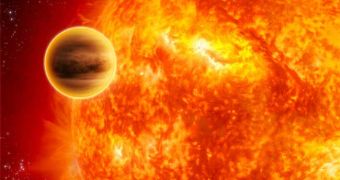A team of scientists from the University College London in the UK, led by Giovanna Tinetti, has discovered the presence of carbon dioxide within the atmosphere of an extra solar planet some 65 light years far from the Earth. This is a major discovery as it proves that carbon dioxide may be present on other worlds as well and because it shows that we are able to detect it. The discovery was made through the means of the Hubble Space Telescope's Near Infrared Camera and Multi-Object Spectrometer (NICMOS).
The name of the planet in question, HD 189733b, should not be a new one for those of you who have read our recent article concerning hot Jupiters. It's a giant gas planet which revolves around its star from a relatively short distance. Astronomers discovered it by comparing the light recorded while the planet was in front of the star with that when it was behind it, since otherwise HD 189733b would have been impossible to detect, given the immense amount of light its star generates.
"This is the first detection of carbon dioxide in the atmosphere of an extrasolar planet, which means that three of the Big Four biomarkers for habitable/inhabited worlds have now been seen: water, methane, and now carbon dioxide," shared Alan Boss, a planet formation theorist from Carnegie Institution of Washington, not involved in the study, as quoted by LiveScience. "The only one that has not yet been detected is oxygen/ozone."
Carbon dioxide is among the most important products of life, so the presence of the chemical compound in the extremely hot foreign planet's atmosphere eludes the experts. Their current theory related to the source of the planet's CO2 states that, since the distance to its star is so small, perhaps the massive amounts of radiation it receives cause some chemicals to break down into the gaseous compound.

 14 DAY TRIAL //
14 DAY TRIAL //